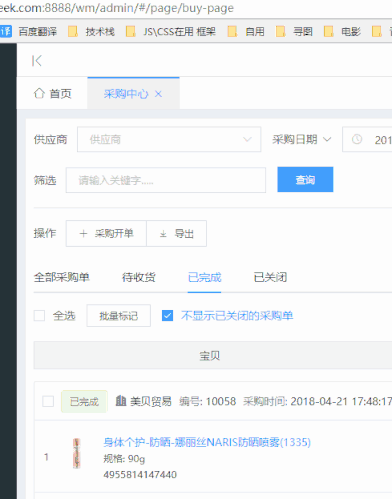
This time I will bring you how to use vue router to operate dynamic routing so that each sub-route is an independent component, and use vue router to operate dynamic routing so that each sub-route is an independent component. Notes Yes Which ones, the following are practical cases, let’s take a look.
vue-router's dynamic routing
vue-router官网上面是这样说的
// 带查询参数,变成 /register?plan=private
router.push({ path: 'register', query: { plan: 'private' }})
然后,我就这样写了:
this.$router.push({path:'manage', query: {id: 'tasklist'}})1
结果很明显,失败了。然后我就默默的再次看了一下官网,结果发现了这句话
// 命名的路由
router.push({ name: 'user', params: { userId: 123 }})
// 带查询参数,变成 /register?plan=private
router.push({ path: 'register', params: { plan: 'private' }})
注意:如果提供了 path,params 会被忽略,上述例子中的 query 并不属于这种情况。取而代之的是下面例子的做法,你需要提供路由的 name 或手写完整的带有参数的 path:
const userId = 123
router.push({ name: 'user', params: { userId }}) // -> /user/123
router.push({ path: `/user/${userId}` }) // -> /user/123
// 这里的 params 不生效
router.push({ path: '/user', params: { userId }}) // -> /user
谨记啊,动态实现二级路由,需要先用变量保存二级路由名称(let router = 'tasklist'),然后调用this.$router.push({path: `/user/${router}`}).Let's take a look at the solution of making each sub-route an independent component under vue router dynamic routing
Because vue-router adopts a component reuse strategy for nested routing, this is indeed an efficient approach in most scenarios, but if you encounter this situation:

If multiple sub-routes are required to co-exist, and there is a need for frequent switching back and forth, it is very desirable to make each sub-route an independent component, although it can be switched by monitoring the route
watch: {
'$route'(to) {
if (to.meta.path === '/page/buy-details') {
this.id = to.params.id;
this.state()
}
}
},Processing updated data in real time. I have always done this before, including the animation page above, but this is really troublesome. To allow users to accurately return to the display state of the page before switching, there are several things to consider. There were too many things, so I came up with a solution:
The sub-routing component does not involve actual business code, it only maintains a list of opened ids. When the routing is switched here, it determines the ids and the ones that have not been opened. Add, loop out the actual sub-routing components through this list, v-show the current id, so that each instance can be independent
I wrote a mixins based on this idea
details -page.js
export default {
watch: {
'$route'(to, from) {
this.detailsLeave(from);
this.detailsOpen(to);
}
},
data() {
return {
pagePath: '',
pageId: 0,
pages: {}
}
},
methods: {
/**
* 子页面打开触发
* @param route
*/
detailsOpen(route) {
if (this.detailsPathGet(route.path) === this.pagePath) {
if (!this.pages[route.params.id]) {
this.$set(this.pages, route.params.id, {
id: route.params.id,
scrollTop: 0
})
}
//路由打开 跳转滚动条
this.pageId = route.params.id;
this.$nextTick(()=>{
this.$parent.$el.firstChild.scrollTop = this.pages[route.params.id].scrollTop;
});
}
},
/**
* 路由切换触发
* 判断离开的路由是否是当前页面,如果是则记录滚动条高度
* @param route
*/
detailsLeave(route) {
if (this.detailsPathGet(route.path) === this.pagePath) {
if (this.pages[route.params.id]) {
//记录滚动条高度 此处针对ea-admin后台 不同的框架要记录的滚动条el不同
this.pages[route.params.id].scrollTop = this.$parent.$el.firstChild.scrollTop ;
}
}
},
/**
* 子页面关闭函数
* @param id
*/
detailsClose(id) {
delete this.pages[id]
},
/**
* 取路由不含最后一项参数的地址
* @param path
* @returns {string}
*/
detailsPathGet(path) {
const i = path.lastIndexOf('/');
return path.substr(0, i);
}
},
mounted() {
//通过当前路由地址创建页面识别地址 注:只对path: '/user/:id' 有效 当 path: /user/:id/profile 失效
this.pagePath = this.detailsPathGet(this.$route.path);
//执行第一次子页面打开
this.detailsOpen(this.$route);
//监听标签关闭消息 此处针对ea-admin后台 不同框架监听关闭方式不同
this.$tabs.onRemove((page, next) => {
//收到标签关闭回调,判断关闭的是否是当前页面
if (page._path === this.pagePath) {
//触发子页面删除
this.detailsClose(page.id)
}
next()
})
}
}Details.vue
<template>
<p>
<your-component
v-for="item in pages"
:id="item.id"
:key="item.id"
v-show="item.id === pageId">
</your-component>
</p>
</template>
<script>
import YourComponent from '';
import detailsPage from '../mixins/details-page'
export default {
name: 'DetailsPage',
components: {YourComponent},
mixins: [detailsPage],
}
</script>In this way, the component can only focus on processing its own fixed data. Because the component is unique, there is no need to worry about storing the view state for each ID.
I believe you have mastered the method after reading the case in this article. For more exciting information, please pay attention to other related articles on the php Chinese website!
Recommended reading:
How to use vue implements SMS verification performance optimization
The above is the detailed content of Use vue router to operate dynamic routing so that each sub-route is an independent component. For more information, please follow other related articles on the PHP Chinese website!




